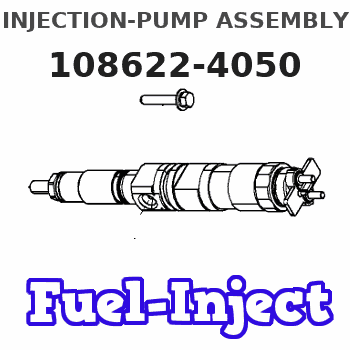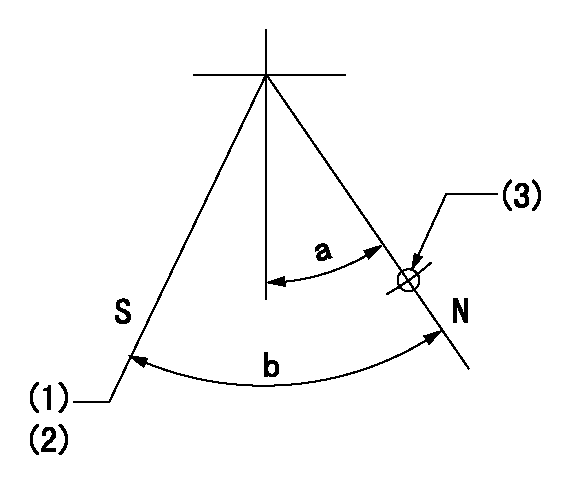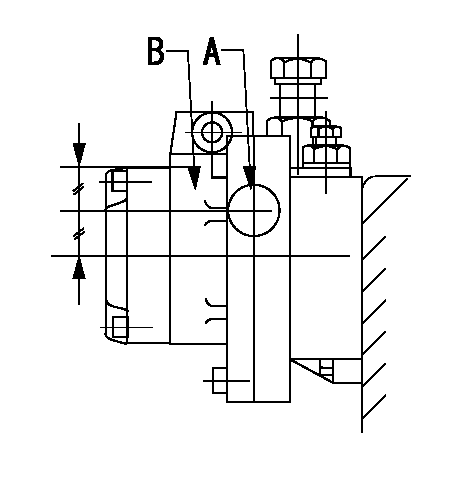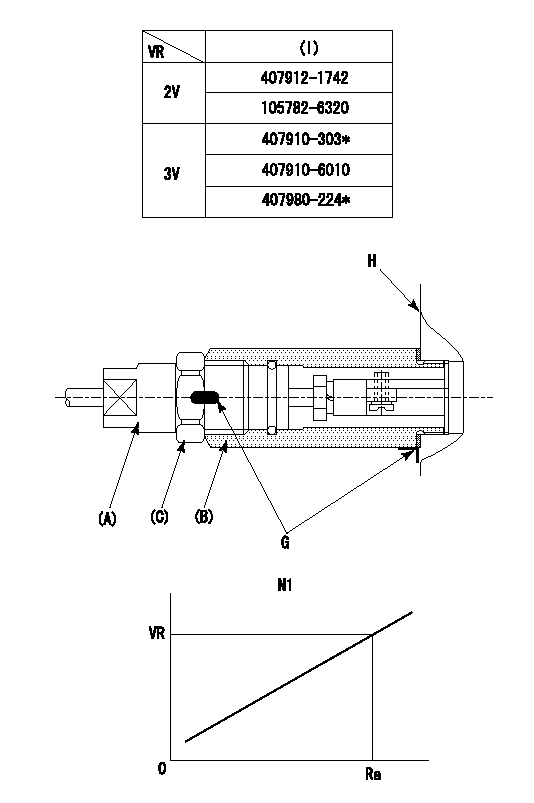Information injection-pump assembly
BOSCH
9 400 612 093
9400612093
ZEXEL
108622-4050
1086224050

Rating:
Service parts 108622-4050 INJECTION-PUMP ASSEMBLY:
1.
_
5.
AUTOM. ADVANCE MECHANIS
9.
_
11.
Nozzle and Holder
12.
Open Pre:MPa(Kqf/cm2)
18.1{185}/24.5{250}
14.
NOZZLE
Include in #1:
108622-4050
as INJECTION-PUMP ASSEMBLY
Cross reference number
BOSCH
9 400 612 093
9400612093
ZEXEL
108622-4050
1086224050
Zexel num
Bosch num
Firm num
Name
Calibration Data:
Adjustment conditions
Test oil
1404 Test oil ISO4113 or {SAEJ967d}
1404 Test oil ISO4113 or {SAEJ967d}
Test oil temperature
degC
40
40
45
Nozzle and nozzle holder
105780-8250
Bosch type code
1 688 901 101
Nozzle
105780-0120
Bosch type code
1 688 901 990
Nozzle holder
105780-2190
Opening pressure
MPa
20.7
Opening pressure
kgf/cm2
211
Injection pipe
Outer diameter - inner diameter - length (mm) mm 8-3-600
Outer diameter - inner diameter - length (mm) mm 8-3-600
Overflow valve
131424-8020
Overflow valve opening pressure
kPa
255
221
289
Overflow valve opening pressure
kgf/cm2
2.6
2.25
2.95
Tester oil delivery pressure
kPa
255
255
255
Tester oil delivery pressure
kgf/cm2
2.6
2.6
2.6
PS/ACT control unit part no.
407980-2
24*
Digi switch no.
33
Direction of rotation (viewed from drive side)
Right R
Right R
Injection timing adjustment
Direction of rotation (viewed from drive side)
Right R
Right R
Injection order
1-5-3-6-
2-4
Pre-stroke
mm
6.4
6.37
6.43
Beginning of injection position
Governor side NO.1
Governor side NO.1
Difference between angles 1
Cal 1-5 deg. 60 59.75 60.25
Cal 1-5 deg. 60 59.75 60.25
Difference between angles 2
Cal 1-3 deg. 120 119.75 120.25
Cal 1-3 deg. 120 119.75 120.25
Difference between angles 3
Cal 1-6 deg. 180 179.75 180.25
Cal 1-6 deg. 180 179.75 180.25
Difference between angles 4
Cyl.1-2 deg. 240 239.75 240.25
Cyl.1-2 deg. 240 239.75 240.25
Difference between angles 5
Cal 1-4 deg. 300 299.75 300.25
Cal 1-4 deg. 300 299.75 300.25
Injection quantity adjustment
Adjusting point
-
Rack position
13.9
Pump speed
r/min
600
600
600
Average injection quantity
mm3/st.
147
145
149
Max. variation between cylinders
%
0
-2
2
Basic
*
Fixing the rack
*
PS407980-224*
V
2.2+-0.0
1
PS407980-224*
mm
4+-0.05
Standard for adjustment of the maximum variation between cylinders
*
Injection quantity adjustment_02
Adjusting point
Z
Rack position
8.5+-0.5
Pump speed
r/min
310
310
310
Average injection quantity
mm3/st.
20
18
22
Max. variation between cylinders
%
0
-15
15
Fixing the rack
*
PS407980-224*
V
V1+0.05+
-0.01
PS407980-224*
mm
6.3+-0.0
3
Standard for adjustment of the maximum variation between cylinders
*
Remarks
Refer to items regarding the pre-stroke actuator
Refer to items regarding the pre-stroke actuator
Injection quantity adjustment_03
Adjusting point
A
Rack position
R1(13.9)
Pump speed
r/min
600
600
600
Average injection quantity
mm3/st.
147
145
149
Basic
*
Fixing the lever
*
Boost pressure
kPa
69.3
69.3
Boost pressure
mmHg
520
520
PS407980-224*
V
2.2+-0.0
1
PS407980-224*
mm
4+-0.05
Injection quantity adjustment_04
Adjusting point
B
Rack position
(R1+0.95
)+0.05-0
.1
Pump speed
r/min
1000
1000
1000
Average injection quantity
mm3/st.
133
127
139
Fixing the lever
*
Boost pressure
kPa
69.3
69.3
Boost pressure
mmHg
520
520
PS407980-224*
V
2.2+-0.0
1
PS407980-224*
mm
4+-0.05
Boost compensator adjustment
Pump speed
r/min
300
300
300
Rack position
R1-2.05
Boost pressure
kPa
14.7
13.4
16
Boost pressure
mmHg
110
100
120
Boost compensator adjustment_02
Pump speed
r/min
300
300
300
Rack position
R1(13.9)
Boost pressure
kPa
56
56
56
Boost pressure
mmHg
420
420
420
0000001601
Pre-stroke
mm
6.4
6.37
6.43
Remarks
When the timing sleeve is pushed up
When the timing sleeve is pushed up
_02
Connector angle
deg.
11.5
11
12
Remarks
When the eccentric pin is tightened
When the eccentric pin is tightened
_03
Supply voltage
V
24
23.5
24.5
Ambient temperature
degC
23
18
28
Pre-stroke
mm
2.4
2.35
2.45
Output voltage
V
2.95
2.94
2.96
Adjustment
*
_04
Supply voltage
V
24
23.5
24.5
Ambient temperature
degC
23
18
28
Pre-stroke
mm
6.4
6.37
6.43
Output voltage
V
1.2
1
1.4
Confirmation
*
Remarks
Output voltage V1
Output voltage V1
_05
Supply voltage
V
24
23.5
24.5
Ambient temperature
degC
23
18
28
Output voltage
V
3.05
3.05
Confirmation of operating range
*
Test data Ex:
Governor adjustment

N:Pump speed
R:Rack position (mm)
(1)Torque cam stamping: T1
(2)Tolerance for racks not indicated: +-0.05mm.
(3)Microswitch adjustment unnecessary.
(4)Boost compensator stroke: BCL
(5)Damper spring setting
----------
T1=AG85 BCL=2.05+-0.1mm
----------
----------
T1=AG85 BCL=2.05+-0.1mm
----------
Speed control lever angle

F:Full speed
I:Idle
(1)Use the hole at R = aa
(2)Stopper bolt set position 'H'
----------
aa=37.5mm
----------
a=2deg+-5deg b=34deg+-3deg
----------
aa=37.5mm
----------
a=2deg+-5deg b=34deg+-3deg
Stop lever angle

N:Pump normal
S:Stop the pump.
(1)Speed = aa, rack position = bb
(2)Set the stopper screw.
(3)Use the hole above R = cc
----------
aa=1200r/min bb=3.5+-0.3mm cc=25mm
----------
a=29.5deg+-5deg b=40deg+-5deg
----------
aa=1200r/min bb=3.5+-0.3mm cc=25mm
----------
a=29.5deg+-5deg b=40deg+-5deg
0000001301

(1)Pump vertical direction
(2)Coupling's key groove position at No 1 cylinder's beginning of injection
(3)B.T.D.C.: aa
(4)Pre-stroke: bb
----------
aa=14deg bb=6.4+-0.03mm
----------
a=(7deg)
----------
aa=14deg bb=6.4+-0.03mm
----------
a=(7deg)
0000001901

A:Sealing position
B:Pre-stroke actuator
1. When installing the pre-stroke actuator on the pump, first tighten the installation bolts loosely, then move the actuator fully counterclockwise (viewed from the drive side).
Temporary tightening torque: 1 - 1.5 N.m (0.1 - 0.15 kgf.m)
2. Move the actuator in the clockwise direction when viewed from the drive side, and adjust so that it becomes the adjustment point of the adjustment value. Then tighten it.
Tightening torque: 7^9 N.m (0.7^0.9 kgf.m)
3. After prestroke actuator installation adjustment, simultaneously stamp both the actuator side and housing side.
----------
----------
----------
----------
0000002201 RACK SENSOR

(VR) measurement voltage
(I) Part number of the control unit
(G) Apply red paint.
(H): End surface of the pump
1. Rack sensor adjustment (-0620)
(1)Fix the speed control lever at the full position
(2)Set the speed to N1 r/min.
(If the boost compensator is provided, apply boost pressure.)
(3)Adjust the bobbin (A) so that the rack sensor's output voltage is VR+-0.01.
(4)At that time, rack position must be Ra.
(5)Apply G at two places.
Connecting part between the joint (B) and the nut (F)
Connecting part between the joint (B) and the end surface of the pump (H)
----------
N1=1000r/min Ra=(R1+0.95)+0.05-0.1mm
----------
----------
N1=1000r/min Ra=(R1+0.95)+0.05-0.1mm
----------
Information:
Supplemental Coolant Additive (SCA)
Supplemental cooling system additive contains alkali. To prevent personal injury, do not drink, avoid contact with the skin and eyes.
The cooling system MUST contain supplemental coolant additive (SCA) for proper engine protection, regardless of antifreeze concentration.
DO NOT mix Caterpillar SCA or coolant additive elements with another manufacturer's products: select a cooling system treatment and use it exclusively.
SCA is necessary for proper conventional coolant maintenance. Most coolants DO NOT contain sufficient SCA for diesel engine application.
Do not exceed the recommended six percent SCA concentration. Excessive SCA concentration can form deposits on the higher temperature surfaces of the cooling system, reducing the engine's heat transfer characteristics. Reduced heat transfer could cause cracking of the cylinder head and other high temperature components. Excessive SCA concentration could also result in radiator tube blockage, overheating, and/or accelerated water pump seal wear. Never use both liquid SCA and the spin-on element (if equipped) at the same time. The use of those additives together could result in SCA concentration exceeding the recommended six percent maximum.
Use liquid SCA or a SCA element (if equipped) to maintain a three to six percent SCA concentration in the coolant. Caterpillar Test Kits check for concentration of nitrites in the coolant solution. Some manufacturers' SCA are phosphate based. Caterpillar Test Kits provide inaccurate results with phosphate based SCA. Commercial SCA products must contain silicates and a minimum of 70 grams per 3.8 L (1 US gal) (1200 ppm) nitrites. If another manufacturer's SCA is used, use that manufacturer's test kit. Follow the manufacturer's recommendations for cooling system treatment and test evaluation.Test the coolant periodically to monitor SCA levels. Use the 4C9301 Test Kit to check for Caterpillar SCA concentration. The Kit also provides cooling system maintenance recommendations. This kit is specifically for use with Caterpillar SCA's. The 8T5296 Test Kit can also to check for Caterpillar SCA concentration.The following charts lists the part numbers and quantities of SCA (liquid and solid) available from your Caterpillar dealer. Follow the instructions on the label. Permitted-Water/SCA Coolant
Never use water alone without SCA or inhibited coolant. Water alone is corrosive at engine operating temperatures.
A mixture of water and SCA does not protect against freezing or boiling.
A coolant mixture of water and SCA will cool and provide some protection to engine components, but it will NOT provide normal engine service life.
Caterpillar's recommendation for proper coolant is a minimum concentration of 30 percent glycol and 70 percent Acceptable water and SCA (3 percent of the total mixture). This recommendation will maintain cooling system corrosion protection.
In applications where freeze protection is not required, or where antifreeze is not available, a coolant mixture of Acceptable water and SCA can be used. A Water/SCA system should maintain a six to eight percent SCA concentration. DO NOT exceed eight percent maximum SCA concentration. SCA concentration levels must be monitored.The 8T5296 Test Kit can be used to evaluate the SCA concentration in Water/SCA coolant, with the following modifications to label instruction Step 3 and Step 5.3. Add tap
Supplemental cooling system additive contains alkali. To prevent personal injury, do not drink, avoid contact with the skin and eyes.
The cooling system MUST contain supplemental coolant additive (SCA) for proper engine protection, regardless of antifreeze concentration.
DO NOT mix Caterpillar SCA or coolant additive elements with another manufacturer's products: select a cooling system treatment and use it exclusively.
SCA is necessary for proper conventional coolant maintenance. Most coolants DO NOT contain sufficient SCA for diesel engine application.
Do not exceed the recommended six percent SCA concentration. Excessive SCA concentration can form deposits on the higher temperature surfaces of the cooling system, reducing the engine's heat transfer characteristics. Reduced heat transfer could cause cracking of the cylinder head and other high temperature components. Excessive SCA concentration could also result in radiator tube blockage, overheating, and/or accelerated water pump seal wear. Never use both liquid SCA and the spin-on element (if equipped) at the same time. The use of those additives together could result in SCA concentration exceeding the recommended six percent maximum.
Use liquid SCA or a SCA element (if equipped) to maintain a three to six percent SCA concentration in the coolant. Caterpillar Test Kits check for concentration of nitrites in the coolant solution. Some manufacturers' SCA are phosphate based. Caterpillar Test Kits provide inaccurate results with phosphate based SCA. Commercial SCA products must contain silicates and a minimum of 70 grams per 3.8 L (1 US gal) (1200 ppm) nitrites. If another manufacturer's SCA is used, use that manufacturer's test kit. Follow the manufacturer's recommendations for cooling system treatment and test evaluation.Test the coolant periodically to monitor SCA levels. Use the 4C9301 Test Kit to check for Caterpillar SCA concentration. The Kit also provides cooling system maintenance recommendations. This kit is specifically for use with Caterpillar SCA's. The 8T5296 Test Kit can also to check for Caterpillar SCA concentration.The following charts lists the part numbers and quantities of SCA (liquid and solid) available from your Caterpillar dealer. Follow the instructions on the label. Permitted-Water/SCA Coolant
Never use water alone without SCA or inhibited coolant. Water alone is corrosive at engine operating temperatures.
A mixture of water and SCA does not protect against freezing or boiling.
A coolant mixture of water and SCA will cool and provide some protection to engine components, but it will NOT provide normal engine service life.
Caterpillar's recommendation for proper coolant is a minimum concentration of 30 percent glycol and 70 percent Acceptable water and SCA (3 percent of the total mixture). This recommendation will maintain cooling system corrosion protection.
In applications where freeze protection is not required, or where antifreeze is not available, a coolant mixture of Acceptable water and SCA can be used. A Water/SCA system should maintain a six to eight percent SCA concentration. DO NOT exceed eight percent maximum SCA concentration. SCA concentration levels must be monitored.The 8T5296 Test Kit can be used to evaluate the SCA concentration in Water/SCA coolant, with the following modifications to label instruction Step 3 and Step 5.3. Add tap